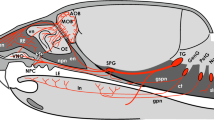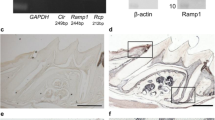Abstract.
Substance P (SP) is an important member of the tachykinin family of neuropeptides, which work as neurotransmitters or neuromodulators. Recent advances in the analysis of SP receptors, particularly the neurokinin-1 receptors (NK1-Rs) that have high affinity for SP, have demonstrated that they are distributed not only in the cells of the neuronal or immune systems but also in peripheral cells. Therefore, the effect of SP and its cellular receptors is not limited to the nervous or immune systems, but is more extensive than previously appreciated. SP-like immunoreactive (SP-LI) axons have been localized in both bone and gingival tissue, and SP receptors are widely distributed in osteoclasts, osteoblasts, and junctional epithelial cells, as well as in neutrophils and endothelial cells. The distribution of SP-LI axons and SP receptors suggests that SP may directly modulate bone metabolism and gingival tissue functions through SP receptors.
Similar content being viewed by others
Author information
Authors and Affiliations
Additional information
Received: March 18, 2001 / Accepted: March 24, 2001
Rights and permissions
About this article
Cite this article
Goto, T., Kido, M., Yamaza, T. et al. Substance P and substance P receptors in bone and gingival tissues. Med Electron Microsc 34, 77–85 (2001). https://doi.org/10.1007/s007950170001
Issue Date:
DOI: https://doi.org/10.1007/s007950170001




